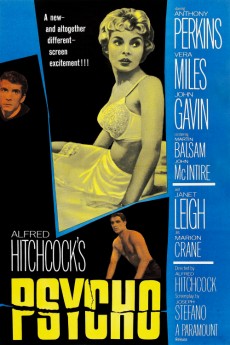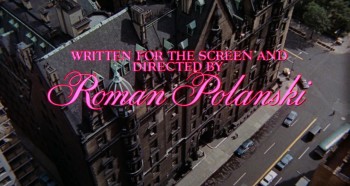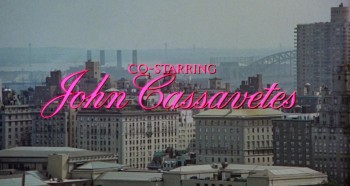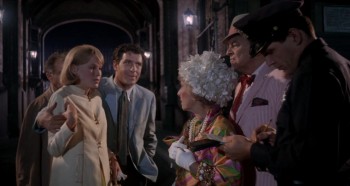Rosemary's Baby was originally proposed as a project to Alfred Hitchcock. He turned it down, and instead it fell to the up-and-coming Polish director Roman Polanski. It's hard to imagine what the master of suspense would have made out of this tale of devil worship and Catholic guilt, even though there is some Hitchockian psychology and mystery at work. As it was however, it proved to be right up the young Polanski's street, taking his career to new heights, and spawning a run of occult horrors in the late 60s and early 70s, of which this is still one of the few greats.
Polanski had already established himself as a director most comfortable with the confinement of interiors in films like Repulsion (1965). Here he draws us right into the claustrophobic feel of the upstairs apartment, often placing the camera in a room adjacent to the action, with the characters viewed through a doorway. The camera movement is mostly restricted to pans. It rarely tracks or dollys, as if it were trapped in a corner. Even in the exterior scenes the sky is often sandwiched or blotted out altogether between the buildings rising on either side. The actors often appear uncomfortably close to the camera, but not in individual close-up shots. Instead, they come in that close as they move around the set and the camera pans back and forth. Not only does this add to the cramped, awkward atmosphere, but this constantly changing distancing of actors within a single shots makes the audience feel as if they are actually standing there.
Rosemary's Baby may come across as very slow to some viewers. 140 minutes certainly is a long time in the horror genre. There do also appear to be a lot of unnecessary details in the dialogue we get to find out far more about Rosemary's background than is normal for a character in cinema. But for one thing, Polanski was not interested in making a shock-and-gore horror Rosemary's Baby is all about the eerie atmosphere, the tension and the mystery. He holds our attention by regularly dropping in clues that something sinister is afoot. Furthermore, all the detail and depth has its significance in the finished product like the references to Rosemary's Catholic upbringing or the background of the Castavets.
Polanski has never overused flashy techniques no fast editing, zooms or unusual angles that make for a very obvious directorial style. But there is always great complexity and meaning in the look of things the set design, lighting, costume and so on. One of my favourite touches is Mia Farrow's extremely short Vidal Sassoon hairdo that she has done halfway through the film. With her bony features and pale skin she more and more begins to resemble a skeleton, especially under the carefully placed lighting in the scene after the party when she realises the pain has gone. It's simple yet significant ideas like that which make Polanski one of the best directors of his era.
There's some great casting in this picture. Careful choice of character actors makes for some quirky supporting roles. Mia Farrow and John Cassavetes are perfect in the lead roles. The musical score that haunting opening melody, or the atonal violin squeaks all add to the atmosphere.
Rosemary's Baby is a real landmark in horror. It helped keep the genre alive by pushing the occult - something fairly taboo, and not fully explored in cinema since the days of silents - to the fore. Also the restrained atmospheric horror was doubtless influential, particularly on Kubrick when he came to make The Shining. It inspired a lot, but was rarely bettered.
Rosemary's Baby
1968
Action / Drama / Fantasy / Horror
Rosemary's Baby
1968
Action / Drama / Fantasy / Horror
Plot summary
A young couple, Rosemary and Guy, moves into an infamous New York apartment building, known by frightening legends and mysterious events, with the purpose of starting a family.
Uploaded by: OTTO
October 26, 2023 at 07:35 AM
Director
Top cast
Tech specs
720p.BLU 1080p.BLU 2160p.BLU.x265Movie Reviews
"Awful things happen in every apartment house"
An atmosphere like no other.
This is how horror films need to be made. Aside from The House of the Devil (a beautiful throwback to this period of the genre) there aren't any films that can so perfectly create this kind of a chilling atmosphere that keeps your skin tingling from start to finish. From the haunting echo of Mia Farrow's voice eerily leading us in, Rosemary's Baby immediately absorbs you into it's world and never lets you out. That's the perfect word for this; absorbing. Roman Polanski is one of cinema's finest directors and what makes him stand as such is how perfectly he can create an atmosphere. Even in his few failures he crafts a unique and full atmosphere that is expertly made for the film he's creating. He's one of the few directors who always know what he's doing and always creates a complete vision that never wavers. That's on display in spades in Rosemary's Baby, a film that drives mystery, supernatural paranoia and the fears of any pregnant woman into the heart of the viewer. With the help of a revelatory performance in terror from Farrow, Polanski creates a truly perfect film.
















